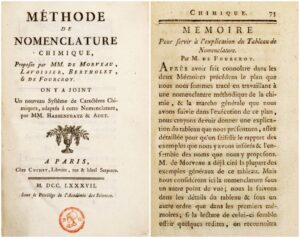
Antoine François de Fourcroy
15 June 1755 – 16 December 1809

Fourcroy was born in Paris, the son of an apothecary in the household of the Duke of Orléans. On the advice of the anatomist Félix Vicq-d’Azyr (1748–1794) he studied medicine and obtained the title of doctor of medicine in 1780. He taught chemistry from (1783–1787) at the Veterinary School of Alfort. Fourcroy’s attention was turned specifically to chemistry by JBM Bucquet (1746–1780), professor of chemistry at the Medical School of Paris and member of the French Royal Academy of Sciences. Bucquet published with Lavoisier 26 memoirs at the Academy of Sciences. In 1784 Fourcroy was chosen to succeed PJ Macquer (1718–1784) as lecturer in chemistry at the college of the Jardin du Roi.
Fourcroy was rapidly convinced of the use of chemistry in medicine and saw great importance in studying the composition of plants and animals, particularly for medical use. The majority of this work was done cooperating with Vauquelin, who became his assistant in 1784.
Fourcroy publish three memoirs containing results concerning the chemistry of the human brain. In the first, he described the conditions of the brains of cadavers. In the second, he reported results on his chemical experimentation on the fatty matter in the brain, as well as its inorganic components. By using newer methods, such as extraction and qualitative analysis, Fourcroy concluded that the brain was composed of fatty acids in combination with bases. The third memoir was a continuation of the separations and extractions he performed on brain matter and addition of various chemical constituents. One of the most fruitful results of this work was the rediscovery of phosphorus in the brain, reintroducing the 1719 discovery by Johann Thomas Hensing.
Fourcroy will remain famous for having been an initiator of chemical nomenclature besides other French chemists: de Morveau, Lavoisier, and Berthollet (Méthode de nomenclature chimique, Chez Cuchet, 1787).

Fourcroy also had a prominent role in developing law that would affect medical education in creating an integration of medicine and surgery in new health schools. Furthermore, he proposed a program in 1791 to establish more effective clinical laboratories.
The social contribution of Fourcroy was important during the French Revolution. In 1792, he had been elected fourth substitute deputy from Paris to the National Convention. On July 25, 1793, he replaced Marat, who was assassinated on July 13, at the National Convention, and he was elected to the Committee of Public Instruction. He would subsequently hold other high ranking positions and directorships in educational institutes and museums during the revolutionary regime and Napoleon’s government as well. As an important counselor to Bonaparte, Fourcroy was appointed Minister of Public Instruction in 1802 until his death, responsible for education in France at all levels. He was very active in the organization of public education and contributed to establish the scientific programs, for primary and secondary schools. Furthermore, he participated in the development of general laws which structured French public education (Ecoles Normales, Muséum d’Histoire Naturelle, Ecole Polytechnique, Ecole des Mines, Lycées).
His main scientific publications are:
AF de Fourcroy, Élémens d’histoire naturelle et de chimie, Chez Cuchet, Paris, 1782
AF de Fourcroy, Philosophie chimique : Vérités fondamentales de la chimie moderne, disposées dans un nouvel ordre, Imprimerie de Cl. Simon, Paris, 1792
AF de Fourcroy, A. Système des connaissances chimiques et de leurs applications aux phénomènes de la nature et de l’art, Baudouin, Paris, 1801–1802
DISPERSIVE LIQUID-LIQUID MICROEXTRACTION
Lire la suiteDevenez membre et participez au développement de la Lipidomique au XXIème siècle.
S'inscrire